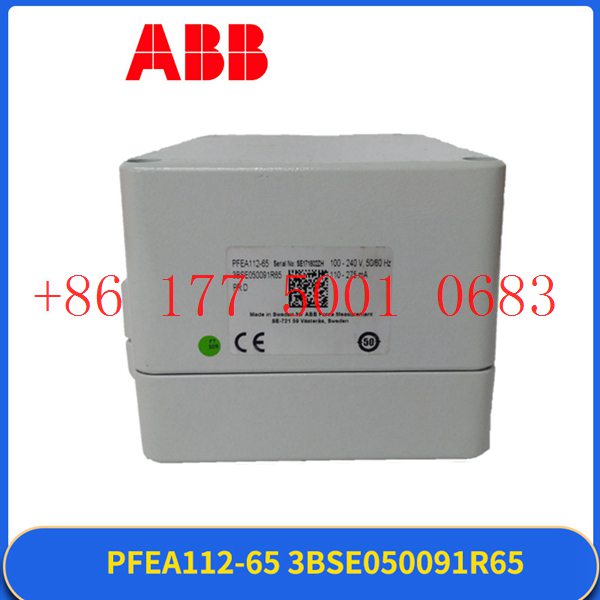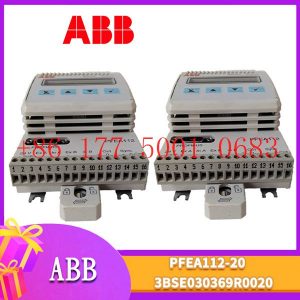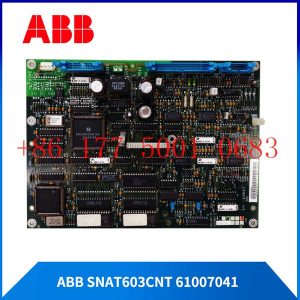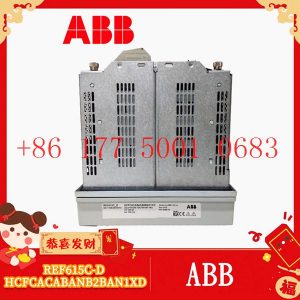Description
hardware flow control. It is an ideal choice in the field of industrial automation.
Implementation of communication between ABC industrial robot and PLC based on DeviceNet fieldbus technology
introduction
In modern production systems, industrial robots and PLCs need to communicate and collaborate to complete production tasks. That is, the
industrial robots output signals to the PLC, allowing the PLC to control related equipment to drive the robot”s front-end tools. This article
mainly analyzes the communication problems between ABB industrial robots and PLC based on DeviceNet fieldbus technology.
DeviceNet is a common network communication method in the field of automation. ABB industrial robots establish a network to communicate with
Siemens PLC based on the DeviceNet network.
1Configure DSQC652
There are mainly 5 types of standard I/0 boards commonly used in ABB industrial robots [2]. Except for the different addresses assigned to
them during setup, their configuration methods are basically the same. This article mainly analyzes the ABB standard I/0 board DS0C652, which
mainly builds communication modules based on the DeviceNet network. The DS0C652 board has a distributed I/O module with 16 digital input and 16
digital output interfaces. The board is installed in the ABB industrial robot control cabinet. First, define the specific operation steps of the DS0C652 board,
enter the teach pendant control panel, then enter the configuration menu (Figure 1), select the DeviceNetDevice menu, and add a template to enter Figure 2.
ABB standard I/0 board is hung on the DeviceNet
network, so the address of the module in the network must be set. The jumpers 6 to 12 of terminal x5 are used to determine the address of the module.
The available address range is 10 to 63. Modify the parameters in the template parameters to complete the DS0C652 board settings. Click the drop-down
menu to select the “Use value from template” row, select
“DS0C65224VDCI/0Device”, and then the parameters that need to be set include the address of the I/0 board in the bus.
Figure 1 Configuring DSQC652
2Configure signals and parameters
After completing the DS0C652 board setting, the I/0 signal setting will be performed. Setting the I/0 signal is the basis for establishing communication with
the PLC. The PLC communicates and transmits data with the ABB industrial robot through the I/0 signal and the DS0C652 board. As shown in Figure 3, in the
signal configuration interface, there are many default I/0 points after the system is established. Modification is not allowed. Click “Add” to add signals. When setting
input and output signals, their address range is 0~15. First, enter the signal menu in the configuration options to set the input and output types, and modify the corresponding parameters.
After completing the settings, the computer prompts that you need to restart the settings. If there are multiple signals that need to be defined and the waiting time
is long after restarting multiple times, you can click “Cancel” and wait for all signals to be defined before clicking the “Yes” button to restart. After the signal settings are
completed, click to select “Input and Output” in the ABB menu to check whether all signals have been set.
Figure 2 Configure DSQC652 parameters
Figure 3 Signal parameter settings
During the signal establishment process, attention should be paid to the DSoC652 port and PLC port addresses used, and the corresponding address table should be
established, as shown in Table 1. The robot interacts with the PLC through I/O signals. During the setting process, there must be no errors in the port and address number
of the PLC connected to the DSoC652. If the address is set incorrectly, the communication between the robot and the PLC will not work properly.
The entire robot teaching pendant setting process is shown in Figure 4.
https://www.xmamazon.com
https://www.xmamazon.com
https://www.plcdcs.com/
www.module-plc.com/
https://www.ymgk.com
REX521GHLPSH51G Feeder Protection Relay REX521
REX521GHHPSH07G feeder protection relay REX 521
REX521GHHGSH05G feeder protection relay
REV615 Capacitor bank protection measurement and control device
REB611 Busbar protection measurement and control device
REF630 Feeder protection and measurement and control device
REJ603 Self-powered feeder protection device
REF611 feeder protection and measurement and control device
REM630 motor protection and measurement and control device
REJ601 Feeder protection device
REU611 voltage protection device
RET630 IEC transformer protection measurement and control device
RET620 transformer protection measurement and control device
RIO600 remote I/O unit ABB
ABB YO 110/120V E1/6 YO switching coil
Y-3023-2-H00AA Brushless servo motor
VIPC616 91611524 0360-1152D
VE3008 KJ2005X1-MQ1 12P6381X022 MQ Controller
URRHH POWER MODULE GE
UR6DH I/O modules
UR6CH UR Series I/O module GE UR 6CH
TC-CCR014 97197975-A01 Redundant Net Interface
SMC INR-244-97B-B-X5 Chiller (Table) Rev. 3
REXROTH SE311 Tightening Controller
PXI-7344 Motion controller module
PU516 3BSE013064R1 Engineering Board -PCI
3BSE042234R1 PP835 Operator Panel
3BSE050198R1 PM866K01 PROCESSOR UNIT
PM862K02 3BSE081636R1 Redundant control unit
3BSE018877R2 PFSK152 Signal concentrator board
3BSE050091R65 PFEA112-65 Weighing sensor
P0924JH COMMUNICATION TERMINAL ASSEMBLY
ABB OKYM175W22 10003130 CONTACTOR
NW-BM85C002 network modu
SCXI-1193 500 MHz Multiplexer/Matrix
NI GPIB-140B Bus Extender
PROSOFT MVI56-PDPS processor
MMS6120 Shaft vibration measurement module
MICROSET 104988-E03 Temperature control multi-scan
NEW LYD000A PLC Module
NEW LYA210A HITACHI Power module
LSU-113DG DEIF Load sharing units
K9203A Circulating fan K 9203A
HONEYWELL K4LCN-16 51403519-160 TDC 3000 Memory Processor
NYQUIST IOB-80 SERVO DRIVE I/O BOARD
IS220YDIAS1A Discrete Contact Input I/O module GE









Reviews
There are no reviews yet.